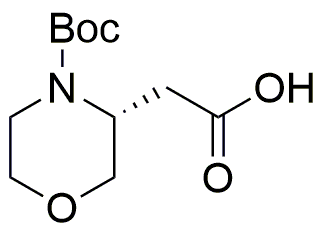(R)-4-Boc-3-morpholineacetic acid is widely utilized in research focused on:
- Synthetic Chemistry: This compound serves as an important building block in the synthesis of various pharmaceuticals, enabling researchers to create complex molecules efficiently.
- Drug Development: Its unique structure allows for the development of new drug candidates, particularly in the field of central nervous system disorders, where it may enhance bioavailability and efficacy.
- Peptide Synthesis: The compound is used in the preparation of peptide derivatives, which are crucial for developing therapeutic agents and vaccines.
- Biochemical Research: It acts as a useful reagent in studying enzyme mechanisms and protein interactions, helping researchers understand biological processes at a molecular level.
- Material Science: The compound can be incorporated into polymer formulations, improving the properties of materials used in coatings and adhesives.
Información general
Propiedades
Seguridad y normativas
Aplicaciones
(R)-4-Boc-3-morpholineacetic acid is widely utilized in research focused on:
- Synthetic Chemistry: This compound serves as an important building block in the synthesis of various pharmaceuticals, enabling researchers to create complex molecules efficiently.
- Drug Development: Its unique structure allows for the development of new drug candidates, particularly in the field of central nervous system disorders, where it may enhance bioavailability and efficacy.
- Peptide Synthesis: The compound is used in the preparation of peptide derivatives, which are crucial for developing therapeutic agents and vaccines.
- Biochemical Research: It acts as a useful reagent in studying enzyme mechanisms and protein interactions, helping researchers understand biological processes at a molecular level.
- Material Science: The compound can be incorporated into polymer formulations, improving the properties of materials used in coatings and adhesives.
Documentos
Hojas de datos de seguridad (HDS)
La SDS proporciona información de seguridad completa sobre la manipulación, el almacenamiento y la eliminación del producto.
Especificación del producto (PS)
La PS proporciona un desglose completo de las propiedades del producto, incluida la composición química, el estado físico, la pureza y los requisitos de almacenamiento. También detalla los rangos de calidad aceptables y las aplicaciones previstas del producto.
Certificados de análisis (COA)
Busque certificados de análisis (COA) ingresando el número de lote del producto. Los números de lote y de partida se pueden encontrar en la etiqueta de un producto después de las palabras "Lote" o "Lote".
Número de catálogo
Número de lote/lote
Certificados de origen (COO)
Este certificado de origen confirma el país en el que se fabricó el producto y también detalla los materiales y componentes utilizados en él y si se deriva de fuentes naturales, sintéticas u otras fuentes específicas. Este certificado puede ser necesario para cumplir con las normativas aduaneras, comerciales y regulatorias.
Número de catálogo
Número de lote/lote
Hojas de datos de seguridad (HDS)
La SDS proporciona información de seguridad completa sobre la manipulación, el almacenamiento y la eliminación del producto.
DownloadEspecificación del producto (PS)
La PS proporciona un desglose completo de las propiedades del producto, incluida la composición química, el estado físico, la pureza y los requisitos de almacenamiento. También detalla los rangos de calidad aceptables y las aplicaciones previstas del producto.
DownloadCertificados de análisis (COA)
Busque certificados de análisis (COA) ingresando el número de lote del producto. Los números de lote y de partida se pueden encontrar en la etiqueta de un producto después de las palabras "Lote" o "Lote".
Número de catálogo
Número de lote/lote
Certificados de origen (COO)
Este certificado de origen confirma el país en el que se fabricó el producto y también detalla los materiales y componentes utilizados en él y si se deriva de fuentes naturales, sintéticas u otras fuentes específicas. Este certificado puede ser necesario para cumplir con las normativas aduaneras, comerciales y regulatorias.


